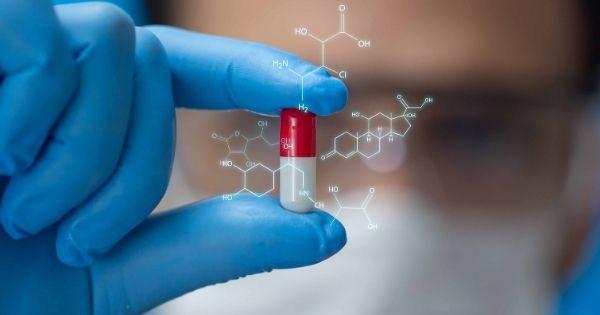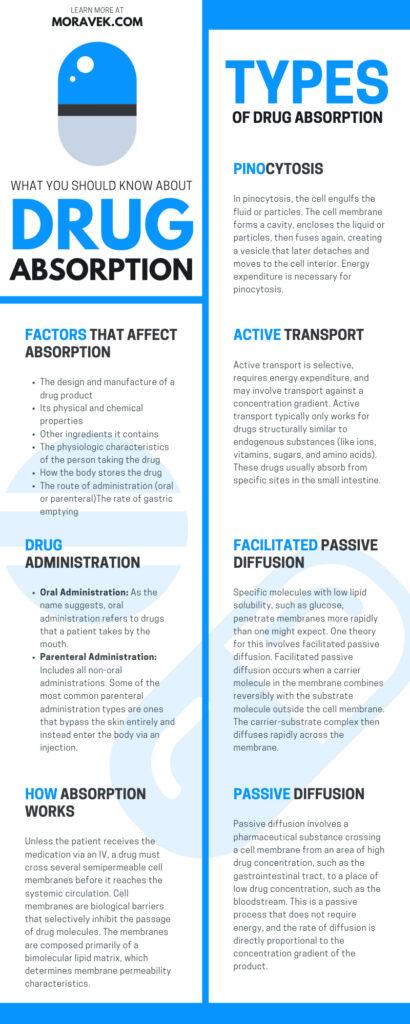
For a drug to be clinically effective, it must absorb into the bloodstream. Absorption is the process of a drug moving from the site of delivery to the bloodstream. The absorption process is crucial to treatment, but it is complex and can be challenging to understand. Here’s what you should know about drug absorption.
Factors That Affect Absorption
Several factors impact absorption, ranging from the drug to the individual’s biological characteristics. A few common factors include:
- The design and manufacture of a drug product
- Its physical and chemical properties
- Other ingredients it contains
- The physiologic characteristics of the person taking the drug
- How the body stores the drug
- The route of administration (oral or parenteral)
- The rate of gastric emptying
Pharmacokinetics Properties
Pharmacokinetic properties indicate what the body does to a drug. Pharmacokinetics of a drug depends on patient-related factors, as well as on the drug’s chemical properties. Below are the two main properties that impact absorption.
- The absorption rate constant: The absorption rate constant is the absorption rate divided by the amount of drug remaining that the body has yet to absorb.
- Bioavailability: Bioavailability refers to the amount of the drug absorbed divide by the drug dose.
One must make a drug soluble to cross the semipermeable cell membranes and reach the systemic circulation. These two parameters are biological barriers to selectively allow or disallow a drug’s particles through the body.
Drug Administration
The type of administration for a drug product significantly impacts the way the body absorbs it.
Oral Administration
As the name suggests, oral administration refers to drugs that a patient takes by the mouth. Oral administration can occur in several ways.
- Tablets: Tablets are one of the most common types of pills. Tablets include active and inactive ingredients in powder form, condensed into a pill that breaks down in the digestive tract.
- Capsules: Like tablets, capsules dissolve in the digestive tract, although they are softer, soluble gelatin rather than a dense tablet.
Parenteral Administration
Parenteral administration includes all non-oral administrations. Some of the most common parenteral administration types are ones that bypass the skin entirely and instead enter the body via an injection.
- Intramuscular injection (IM): This type of injection introduces a substance deep into the muscle tissue for more rapid absorption.
- Subcutaneous injection (SC): “Subcutaneous” means under the skin. A short needle injects medication into the layer between the skin and muscle to slowly absorb over a more extended period.
- Intravenous injection (IV): Intravenous injections deliver medications directly to the bloodstream via an injection into the patient’s vein.
How Absorption Works
Unless the patient receives the medication via an IV, a drug must cross several semipermeable cell membranes before it reaches the systemic circulation. Cell membranes are biological barriers that selectively inhibit the passage of drug molecules. The membranes are composed primarily of a bimolecular lipid matrix, which determines membrane permeability characteristics. Drugs may cross cell membranes through the four main types of drug absorption mentioned below.
Types of Drug Absorption
Absorption can occur in several ways. One of the most important things you should know about drug absorption is the four different types and how they work.
Passive Diffusion
Passive diffusion involves a pharmaceutical substance crossing a cell membrane from an area of high drug concentration, such as the gastrointestinal tract, to a place of low drug concentration, such as the bloodstream.
This is a passive process that does not require energy, and the rate of diffusion is directly proportional to the concentration gradient of the product. Other factors influencing passive diffusion include:
- The physicochemical properties of the drug, such as its:
- lipid solubility
- molecular size
- degree of ionization
- The porous surface area available to the drug
Because the cell membrane is lipoid, lipid-soluble drugs diffuse most rapidly. Small molecules also tend to penetrate membranes more quickly than larger ones.
Most drugs are weak organic acids or bases, existing in un-ionized and ionized forms in an aqueous environment. The un-ionized form is usually lipid-soluble or lipophilic and diffuses readily across cell membranes. The ionized form has a high electrical resistance and low lipid solubility but high-water solubility, making it hydrophilic so that it cannot penetrate cell membranes easily. The proportion of the un-ionized form present and the drug’s ability to cross a membrane will depend on the environmental pH and the drug’s pKa (acid dissociation constant).
Facilitated Passive Diffusion
Specific molecules with low lipid solubility, such as glucose, penetrate membranes more rapidly than one might expect. One theory for this involves facilitated passive diffusion. Facilitated passive diffusion occurs when a carrier molecule in the membrane combines reversibly with the substrate molecule outside the cell membrane. The carrier-substrate complex then diffuses rapidly across the membrane. In doing so, it releases the substrate at the interior surface. In such cases, the membrane transports only substrates with a relatively specific molecular configuration, and the availability of carriers limits the process. The process does not require any energy expenditure, and transport against a concentration gradient cannot occur.
Active Transport
Active transport is selective, requires energy expenditure, and may involve transport against a concentration gradient. Active transport typically only works for drugs structurally similar to endogenous substances (like ions, vitamins, sugars, and amino acids). These drugs usually absorb from specific sites in the small intestine.
Pinocytosis
In pinocytosis, the cell engulfs the fluid or particles. The cell membrane forms a cavity, encloses the liquid or particles, then fuses again, creating a vesicle that later detaches and moves to the cell interior. Energy expenditure is necessary for pinocytosis.
Drug absorption is a complicated process vital to the effectiveness of pharmaceuticals. In summary, absorption works through moving a drug into the bloodstream by crossing many semipermeable cell membranes to reach the systemic circulation. Passive diffusion, facilitated passive diffusion, active transport, and pinocytosis are the four methods that pass the substance into the bloodstream.
As a leading radiochemistry laboratory, Moravek is a renowned expert in the absorption, synthesis, and analysis of radiolabeled compounds in support of medical research and clinical trials.

